New Haven, Connecticut Blood Testing Facilities
 Represents a LabCorp blood testing facility
Represents a LabCorp blood testing facility Represents a Quest Diagnostics blood testing facility
Represents a Quest Diagnostics blood testing facility
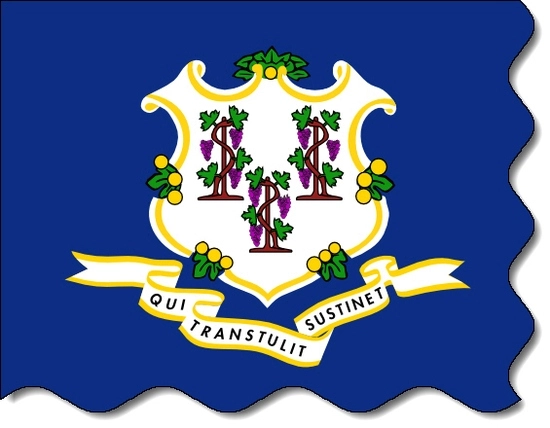
Nearby Labcorp Blood Testing facilities:
- Labcorp Center Distance: 2 m, 755 Campbell Ave Ste 3, West Haven, New Haven County, CT, 6516
- Labcorp Center Distance: 5 m, 3018 Dixwell Ave 3Rd Fl, Hamden, New Haven County, CT, 6518
- Labcorp Center Distance: 16 m, 4750 Main St, Bridgeport, Fairfield County, CT, 6606
- Labcorp Center Distance: 18 m, 1068 W Main St, Waterbury, New Haven County, CT, 6708
- Labcorp Center Distance: 24 m, 45 Route 25A Ste E2, Shoreham, Suffolk County, NY, 11786
- Labcorp Center Distance: 26 m, 5225 Route 347 Bldg 1314, Port Jefferson Stati, Suffolk County, NY, 11776
- Labcorp Center Distance: 27 m, 46 Route 25A Suite 2, Setauket, Suffolk County, NY, 11733
- Labcorp Center Distance: 28 m, 887 Old Country Rd Ste C, Riverhead, Suffolk County, NY, 11901
- Labcorp Center Distance: 30 m, 325 Middle Country Rd Ste C, Selden, Suffolk County, NY, 11784
- Labcorp Center Distance: 31 m, 2500 Nesconset Hwy Ste 30-31, Stony Brook, Suffolk County, NY, 11790
- Labcorp Center Distance: 33 m, 1723 N Ocean Ave Ste D, Medford, Suffolk County, NY, 11763
- Labcorp Center Distance: 34 m, 2 Brooksite Dr, Smithtown, Suffolk County, NY, 11787
- Labcorp Center Distance: 35 m, 617 A Montauk Hwy, Center Moriches, Suffolk County, NY, 11934
- Labcorp Center Distance: 36 m, 1770 Motor Pkwy 2Nd Fl, Hauppauge, Suffolk County, NY, 11788
- Labcorp Center Distance: 37 m, 2171 Jericho Tpke. Suite 200, Commack, Suffolk County, NY, 11725
- Labcorp Center Distance: 39 m, 4830 Sunrise Hwy, Sayville, Suffolk County, NY, 11782
- Labcorp Center Distance: 41 m, 2 Dearfield Dr Ste 101, Greenwich, Fairfield County, CT, 6831
- Labcorp Center Distance: 42 m, 150 Islip Ave Ste 9, Islip, Suffolk County, NY, 11751
- Labcorp Center Distance: 43 m, 57 E Main St, Bay Shore, Suffolk County, NY, 11706
- Labcorp Center Distance: 45 m, 12 Case St Ste 302, Norwich, New London County, CT, 6360
- Labcorp Center Distance: 46 m, 100 Manetto Hill Rd Ste 309, Plainview, Nassau County, NY, 11803
- Labcorp Center Distance: 47 m, 400 W Main St Ste 304, Babylon, Suffolk County, NY, 11702
- Labcorp Center Distance: 48 m, 656 N Wellwood Ave Ste 208A, Lindenhurst, Suffolk County, NY, 11757
- Labcorp Center Distance: 49 m, 297 Knollwood Rd Ste 102, White Plains, Westchester County, NY, 10607
- Labcorp Center Distance: 50 m, 1985 Crompond Rd Bldg B, Cortlandt Manor, Westchester County, NY, 10567
- Labcorp Center Distance: 52 m, 175 Memorial Hwy, New Rochelle, Westchester County, NY, 10801
- Labcorp Center Distance: 53 m, 311 North Midland Ave, Nyack, Rockland County, NY, 10960
- Labcorp Center Distance: 54 m, 300 Old Country Rd Ste 91, Mineola, Nassau County, NY, 11501
- Labcorp Center Distance: 55 m, 984 N Broadway Ste 301, Yonkers, Westchester County, NY, 10701
- Labcorp Center Distance: 56 m, 2 Medical Park Dr Ste 7, West Nyack, Rockland County, NY, 10994
- Labcorp Center Distance: 57 m, 1200 Waters Pl Ste M109, Bronx, Bronx County, NY, 10461
- Labcorp Center Distance: 58 m, 200 E Eckerson Rd Ste 220, New City, Rockland County, NY, 10956
- Labcorp Center Distance: 59 m, 1540 Route 202 Ste 6, Pomona, Rockland County, NY, 10970
- Labcorp Center Distance: 60 m, 136-20 38Th Ave 5L, Flushing, Queens County, NY, 11355
- Labcorp Center Distance: 61 m, 521 West 181St Street, New York, New York County, NY, 10033
- Labcorp Center Distance: 62 m, 33-54 83Rd St Ste G-02, Jackson Heights, Queens County, NY, 11372
- Labcorp Center Distance: 63 m, 222 State Route 299, Highland, Ulster County, NY, 12528
- Labcorp Center Distance: 64 m, 47-01 Queens Blvd 206-207, Sunnyside, Queens County, NY, 11104
- Labcorp Center Distance: 65 m, 745 Route 17M - Ste 102, Monroe, Orange County, NY, 10950
- Labcorp Center Distance: 66 m, 279 Main St Ste 200, New Paltz, Ulster County, NY, 12561
- Labcorp Center Distance: 67 m, 401 Goffle Rd, Ridgewood, Bergen County, NJ, 7450
- Labcorp Center Distance: 68 m, 680 Broadway Unit B3, Paterson, Passaic County, NJ, 7514
- Labcorp Center Distance: 69 m, 368 Broadway Ste 303, Kingston, Ulster County, NY, 12401
- Labcorp Center Distance: 71 m, 330 Washington Avenue, Kingston, Ulster County, NY, 12401
- Labcorp Center Distance: 72 m, 1031 Mcbride Ave Ste D-204, Woodland Park, Passaic County, NJ, 7424
- Labcorp Center Distance: 73 m, 3 Coates Drive, Goshen, Orange County, NY, 10924
- Labcorp Center Distance: 74 m, 38 Hamburg Tpke, Riverdale, Morris County, NJ, 7457
- Labcorp Center Distance: 75 m, 16 W Bridge St, Saugerties, Ulster County, NY, 12477
- Labcorp Center Distance: 76 m, 72 Cudworth Rd, Webster, Worcester County, MA, 1570
- Labcorp Center Distance: 77 m, 345 Henry St Ste 104, Orange, Essex County, NJ, 7050
- Labcorp Center Distance: 78 m, 240 Port Richmond Ave, Staten Island, Richmond County, NY, 10302
Nearby Quest Blood Testing facilities:
- Quest Center Distance: 0 m, 60 Temple Street, New Haven, New Haven County, CT, 06510-2716
- Quest Center Distance: 5 m, 3000 Dixwell Ave, Hamden, New Haven County, CT, 06518-3522
- Quest Center Distance: 9 m, 515 Bridgeport Ave, Shelton, Fairfield County, CT, 06484-5366
- Quest Center Distance: 11 m, 15 South Elm Street, Wallingford, New Haven County, CT, 06492-4741
- Quest Center Distance: 15 m, 555 Lordship Blvd Fl 1, Stratford, Fairfield County, CT, 06615-7156
- Quest Center Distance: 16 m, 11 Woodland Road, Madison, New Haven County, CT, 06443-2342
- Quest Center Distance: 17 m, 816 Broad Street, Ste 22, Meriden, New Haven County, CT, 06450-4364
- Quest Center Distance: 18 m, 60 Westwood Avenue, Waterbury, New Haven County, CT, 06708-2460
- Quest Center Distance: 22 m, 400 Saybrook Rd, Middletown, Middlesex County, CT, 06457-4731
- Quest Center Distance: 25 m, 6144 Route 25A, Wading River, Suffolk County, NY, 11792-2018
- Quest Center Distance: 26 m, 935 Farmington Avenue, Bristol, Hartford County, CT, 06010-3927
- Quest Center Distance: 27 m, 1010 Route 112, Port Jefferson Station, Other, NY, 11776-2054
- Quest Center Distance: 28 m, 74 Commerce Dr, Riverhead, Suffolk County, NY, 11901-3105
- Quest Center Distance: 29 m, 23 Technology Dr, East Setauket, Suffolk County, NY, 11733-4069
- Quest Center Distance: 30 m, 235 Boyle Rd, Selden, Suffolk County, NY, 11784-1900
- Quest Center Distance: 31 m, 465 Silas Deane Highway, Wethersfield, Hartford County, CT, 06109-2134
- Quest Center Distance: 32 m, 131 New London Turnpike, Glastonbury, Hartford County, CT, 06033-2246
- Quest Center Distance: 33 m, 570 Expressway Dr South, Medford, Other, NY, 11763-2049
- Quest Center Distance: 36 m, 285 Sills Rd, East Patchogue, Suffolk County, NY, 11772-4869
- Quest Center Distance: 37 m, 490 Wheeler Rd, Hauppauge, Suffolk County, NY, 11788-4372
- Quest Center Distance: 38 m, 175 E Main St, Huntington, Suffolk County, NY, 11743-2912
- Quest Center Distance: 40 m, 233 Montauk Hwy, West Sayville, Suffolk County, NY, 11796-1811
- Quest Center Distance: 42 m, 83 South Bedford Rd, Mt. Kisco, Westchester County, NY, 10549-3457
- Quest Center Distance: 44 m, 1350 Deer Park Ave, North Babylon, Suffolk County, NY, 11703-1619
- Quest Center Distance: 45 m, 118 New London Turnpike, Norwich, New London County, CT, 06360-2616
- Quest Center Distance: 46 m, 55 Town Street, Norwich, New London County, CT, 06360-2332
- Quest Center Distance: 47 m, 135D Storrs Rd, Mansfield Center, Tolland County, CT, 06250-1638
- Quest Center Distance: 49 m, 280 Dobbs Ferry Rd, White Plains, Westchester County, NY, 10607-1900
- Quest Center Distance: 50 m, 1869A E Main St, Peekskill, Westchester County, NY, 10566-2505
- Quest Center Distance: 52 m, 150 Lockwood Ave, New Rochelle, Westchester County, NY, 10801-4916
- Quest Center Distance: 53 m, 982 Main St, Fishkill, Dutchess County, NY, 12524-3506
- Quest Center Distance: 54 m, 105 Stevens Ave, Mount Vernon, Westchester County, NY, 10550-2680
- Quest Center Distance: 55 m, 970 N Broadway, Yonkers, Westchester County, NY, 10701-1310
- Quest Center Distance: 56 m, 151 N Main St, New City, Rockland County, NY, 10956-3851
- Quest Center Distance: 57 m, 2015 Williamsbridge Rd, Bronx, Bronx County, NY, 10461-1606
- Quest Center Distance: 58 m, 978 Route 45, Pomona, Rockland County, NY, 10970-3528
- Quest Center Distance: 59 m, 2415A Arthur Ave, Bronx, Bronx County, NY, 10458-6076
- Quest Center Distance: 60 m, 136-20 38Th Ave, Flushing, Queens County, NY, 11354-4277
- Quest Center Distance: 61 m, 16624 Jamaica Ave, Jamaica, Queens County, NY, 11432-5241
- Quest Center Distance: 62 m, 7010 Austin St, Forest Hills, Queens County, NY, 11375-1021
- Quest Center Distance: 63 m, 40 08 Forley St, Elmhurst, Queens County, NY, 11373-1427
- Quest Center Distance: 64 m, 210 E 86Th St, New York, New York County, NY, 10028-3003
- Quest Center Distance: 65 m, Indian Rock Shopping Center, Suffern, Rockland County, NY, 10901-4822
- Quest Center Distance: 66 m, 246 Main St, New Paltz, Ulster County, NY, 12561-1608
- Quest Center Distance: 67 m, 247 Third Ave, New York, New York County, NY, 10010-7454
- Quest Center Distance: 68 m, 101 Broadway, Brooklyn, Kings County, NY, 11211-8663
- Quest Center Distance: 69 m, 139 Centre St, New York, New York County, NY, 10013-4552
- Quest Center Distance: 70 m, 224-226 Atlantic Ave, Brooklyn, Kings County, NY, 11201-5727
- Quest Center Distance: 71 m, 380 Washington Ave, Kingston, Ulster County, NY, 12401-3702
- Quest Center Distance: 72 m, 500 Union Blvd, Totowa, Passaic County, NJ, 07512-2579
- Quest Center Distance: 73 m, 30 Hatfield Ln, Goshen, Orange County, NY, 10924-6766
Connecticut Hormone Replacement Therapy Services
The Conscious Evolution Clinic is an Insured and Licensed Medical Clinic which specializes in Hormone Restoration Treatments which optimize health and promote long-term wellness. We have a large and caring staff of experienced clinicians and board-certified physicians, dedicated to serving men and women over the age of thirty throughout the state of Connecticut.
We have streamlined the process required to provide you with the accurate diagnosis and effective treatment that you deserve. We have affiliate doctors all throughout the state of Connecticut that work on our behalf, providing the necessary physical and taking the blood sample that will provide us with all of the information needed to make a complete diagnosis of your hormone status.
HGH Injections for Connecticut Residents
One of the services that we are most proud to provide at the Conscious Evolution Institute is HGH Hormone Replacement Therapy. We feel that Age-Related HGH Deficiency is an under-treated phenomena which can severely impact the physical and psychological health of men and women across the country.
HGH is among the most important hormones produced by our body when it comes to maintaining streamlined and optimized function. Human Growth Hormone is like a throttle for our cellular metabolism, keeping our bodies running as efficiently as possible. HGH Levels start to decline as we enter middle age, however, and many men and women start to lose their vitality as a result of a progressive deficiency of the hormone.
Symptoms of Growth Hormone Deficiency include trouble sleeping, mood swings, changes in body mass, lack of energy, fatigue, poor cholesterol, and reduced cognitive capacity and memory. The Conscious Evolution Institute provides two effective forms of HGH Treatment: Human Growth Hormone Injection Therapy and Sermorelin HGH Alternative. Under most circumstances, both of these treatments are highly effective at restoring hormone balance and mitigating the effects of Growth Hormone Deficiency.
Testosterone Replacement Therapy in Connecticut
We also provide Hormone Restoration Services for men suffering from Testosterone Deficiency. Around middle age, men actually experience a phase of hormonal change that is not entirely unlike menopause. Many doctors actually refer to it as Andropause.
Although the symptoms of Andropause appear much more gradually than menopause, they still have a significant impact on male health: weight gain, frailty, loss of bone mineral density, loss of assertiveness, increased anxiety, and trouble sleeping are all common symptoms, and that's on top of the significant sexual symptoms that are commonly associated with the disorder.
The Conscious Evolution Institute offers comprehensive Testosterone Restoration Therapy for the treatment of Andropause, and you have a number of options when it comes to treatment, from Topical Testosterone to Testosterone Injections and Patches.
Connecticut HCG Therapy for Weight Loss
Not all forms of Hormone Therapy are intended specifically for Hormone Restoration, however. HCG Injections, for example, are actually a highly effective treatment for weight loss. Many men and women struggle significantly with their weight because they are unable to overcome the biggest pitfall of dieting: Hunger.
HCG Injections are incredibly effective because they actually have the ability significantly reduce the uncomfortable sensation of hunger, making it easier to stick with the diet. When HCG Therapy is combined with a Low-Calorie diet, it is possible to lose 5 pounds or more per week, without feeling drained of energy or overwhelmed with hunger.
Major Cities in Connecticut
Bridgeport
Bridgeport is the largest city in the state of Connecticut, and is located on the shores of the southwestern portion of the state. Bridgeport is located on both Long Island Sound and the Pequonnock River. Bridgeport was the city in which the first Subway Restaurant was opened, and P.T. Barnum of the Barnum and Bailey Circus was actually once the mayor of the city.
The largest employers in the city are the People's United Bank, Bridgeport Hospital, and St. Vincent's Medical Center. The city is also home to the University of Bridgeport.
New Haven
New Haven is the second most populous city in Connecticut, and is located slightly to the northeast of Bridgeport, situated on the shore of the eponymously named New Haven Harbor. New Haven is most famous for being the home of the prestigious Ivy League school Yale University, and also goes by the nickname, The Elm City.
Yale University provides the most jobs in the city, but education and healthcare in general are both strong sectors of the local economy. Retail, finance, and marketing also contribute significantly to the New Haven economy.
Stamford
Stamford, Connecticut is located on the southwestern tip of the state, and is the third most populous city in the state of Connecticut. Stamford is located very close to New York City, only around thirty miles from Manhattan. Stamford is considered one of the safest cities both in New England and in the United States as a whole.
Stamford is the most economically active area of Connecticut, with a number of the largest companies headquartered in the city, including Charter Communications, Pitney Bowes, and Crane Companies. A number of companies are based just outside the city limits, including Clairol, NBC, and Xerox.
Hartford
Hartford, Connecticut is the capital city of the state, as well as the fourth most populous city in the state. Because of the state laws in Connecticut, a large number of insurance companies have moved to Hartford to take advantage of the favorable laws, and the city is often referred to as the Insurance Capital of the World.
Hartford has one of the strongest economies in the United States, and is also home to some major national landmarks. Hartford is home to both the oldest park (Bushnell Park), and the oldest art museum (the Wadsworth Atheneum) offered and financed for public use.
Waterbury
Waterbury is located in the west-central region of Connecticut, and is the fifth most populous city in the state. Waterbury garnered the nickname, The Brass City, because it was the number one maker of brassware in the United States. It has also been historically recognized for the clocks and watches made in the region. The largest employers in Waterbury are St. Mary's Hospital, Waterbury Hospital, and the City of Waterbury. Waterbury is home to two museums, the Timexpo Museum and the Mattatuck Museum.
All About New Haven, Connecticut Geographic Area
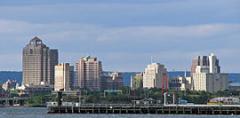

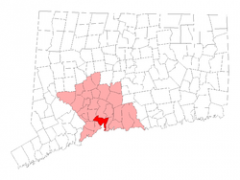
New Haven is the second-largest city in Connecticut, after Bridgeport and the sixth-largest in New England. With a population at the 2010 United States Census of 129,779 people, New Haven is the principal municipality in the Greater New Haven metropolitan area, which had a total population of 862,477 in 2010. It is located on New Haven Harbor on the northern shore of Long Island Sound in New Haven County, which in turn comprises a part of the New York-Newark-Bridgeport, New York-New Jersey-Connecticut-Pennsylvania Combined Statistical Area.
New Haven was founded in 1638 by English Puritans, and a year later eight streets were laid out in a four-by-four grid, creating what is now commonly known as the "Nine Square Plan", now recognized by the American Institute of Certified Planners as a National Planning Landmark. The central common block is New Haven Green, a 16-acre (6 ha) square, now a National Historic Landmark and the center of Downtown New Haven.
New Haven is the home of the Ivy League school Yale University. The university is an integral part of the city's economy, being New Haven's biggest taxpayer and employer, as noted in the Mayor's 2010 State of the City address. Health care (hospitals and biotechnology), professional services (legal, architectural, marketing, and engineering), financial services, and retail trade also help to form an economic base for the city.
New Haven had the first public tree planting program in America, producing a canopy of mature trees (including some large elms) that gave New Haven the nickname "The Elm City".
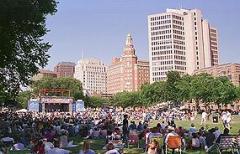
Before Europeans arrived, the New Haven area was the home of the Quinnipiac tribe of Native Americans, who lived in villages around the harbor and subsisted off local fisheries and the farming of maize. The area was briefly visited by Dutch explorer Adriaen Block in 1614. Dutch traders set up a small trading system of beaver pelts with the local inhabitants, but trade was sporadic and the Dutch did not settle permanently in the area.
In 1637 a small party of Puritans reconnoitered the New Haven harbor area and wintered over. In April 1638, the main party of five hundred Puritans who left the Massachusetts Bay Colony under the leadership of the Reverend John Davenport and the London merchant Theophilus Eaton sailed into the harbor. These settlers were hoping to establish a better theological community than the one they left in Massachusetts and sought to take advantage of the excellent port capabilities of the harbor. The Quinnipiacs, who were under attack by neighboring Pequots, sold their land to the settlers in return for protection.
By 1640, the town's theocratic government and nine-square grid plan were in place, and the town was renamed Newhaven from Quinnipiac. However, the area north of New Haven remained Quinnipiac until 1678, when it was renamed Hamden. The settlement became the headquarters of the New Haven Colony. At the time, the New Haven Colony was separate from the Connecticut Colony, which had been established to the north centering on Hartford. One of the principal differences between the two colonies was that the New Haven colony was an intolerant theocracy that did not permit other churches to be established, while the Connecticut colony permitted the establishment of other churches.
Economic disaster struck the colony in 1646, however, when the town sent its first fully loaded ship of local goods back to England. This ship never reached the Old World, and its disappearance stymied New Haven's development in the face of the rising trade power of Boston and New Amsterdam. In 1660, founder John Davenport's wishes were fulfilled, and Hopkins School was founded in New Haven with money from the estate of Edward Hopkins.
In 1661, the judges who had signed the death warrant of Charles I of England were pursued by Charles II. Two judges, Colonel Edward Whalley and Colonel William Goffe, fled to New Haven to seek refuge from the king's forces. John Davenport arranged for these "Regicides" to hide in the West Rock hills northwest of the town. A third judge, John Dixwell, joined the other regicides at a later time.
New Haven became part of the Connecticut Colony in 1664, when the two colonies were merged under political pressure from England, according to folklore as punishment for harboring the three judges (in reality, done in order to strengthen the case for the takeover of nearby New Amsterdam, which was rapidly losing territory to migrants from Connecticut). Some members of the New Haven Colony seeking to establish a new theocracy elsewhere went on to establish Newark, New Jersey.
It was made co-capital of Connecticut in 1701, a status it retained until 1873. In 1716, the Collegiate School relocated from Old Saybrook to New Haven and established New Haven as a center of learning. In 1718, the name of the Collegiate School was changed to Yale College in response to a large donation from British East India Company merchant Elihu Yale, former Governor of Madras.
For over a century, New Haven citizens had fought in the colonial militia alongside regular British forces, as in the French and Indian War. As the American Revolution approached, General David Wooster and other influential residents hoped that the conflict with the government in Britain could be resolved short of rebellion. On 23 April 1775, which is still celebrated in New Haven as Powder House Day, the Second Company, Governor's Foot Guard, of New Haven entered the struggle against the governing British parliament. Under Captain Benedict Arnold, they broke into the powder house to arm themselves and began a three-day march to Cambridge, Massachusetts. Other New Haven militia members were on hand to escort George Washington from his overnight stay in New Haven on his way to Cambridge. Contemporary reports, from both sides, remark on the New Haven volunteers' professional military bearing, including uniforms.
2,600 loyalists and British regulars under General William Tryon, governor of New York, raided the 3,500-person town in July 1779, but did not torch it as they had with Danbury in 1777, or Fairfield and Norwalk a week after the New Haven raid, leaving many of the town's colonial features preserved.
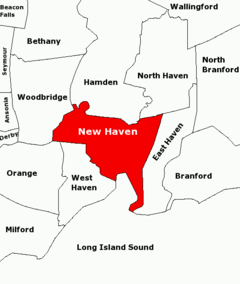
New Haven was incorporated as a city in 1784, and Roger Sherman, one of the signers of the Constitution and author of the "Connecticut Compromise", became the new city's first mayor.
The city struck fortune in the late 18th century with the inventions and industrial activity of Eli Whitney, a Yale graduate who remained in New Haven to develop the cotton gin and establish a gun-manufacturing factory in the northern part of the city near the Hamden town line. That area is still known as Whitneyville, and the main road through both towns is known as Whitney Avenue. The factory is now the Eli Whitney Museum, which has a particular emphasis on activities for children and exhibits pertaining to the A. C. Gilbert Company. His factory, along with that of Simeon North, and the lively clock-making and brass hardware sectors, contributed to making early Connecticut a powerful manufacturing economy; so many arms manufacturers sprang up that the state became known as "The Arsenal of America". It was in Whitney's gun-manufacturing plant that Samuel Colt invented the automatic revolver in 1836.
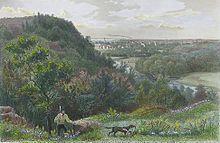
The Farmington Canal, created in the early 19th century, was a short-lived transporter of goods into the interior regions of Connecticut and Massachusetts, and ran from New Haven to Northampton, Massachusetts.
New Haven was home to one of the important early events in the burgeoning anti-slavery movement when, in 1839, the trial of mutineering Mende tribesmen being transported as slaves on the Spanish slaveship Amistad was held in New Haven's United States District Court. There is a statue of Joseph Cinque, the informal leader of the slaves, beside City Hall. See "Museums" below for more information. Abraham Lincoln delivered a speech on slavery in New Haven in 1860, shortly before he secured the Republican nomination for President.
The American Civil War boosted the local economy with wartime purchases of industrial goods, including that of the New Haven Arms Company, which would later become the Winchester Repeating Arms Company. (Winchester would continue to produce arms in New Haven until 2006, and many of the buildings that were a part of the Winchester plant are now a part of the Winchester Repeating Arms Company Historic District.) After the war, population grew and doubled by the start of the 20th century, most notably due to the influx of immigrants from southern Europe, particularly Italy. Today, roughly half the populations of East Haven, West Haven, and North Haven are Italian-American. Jewish immigration to New Haven has left an enduring mark on the city. Westville was the center of Jewish life in New Haven, though today many have fanned out to suburban communities such as Woodbridge and Cheshire.
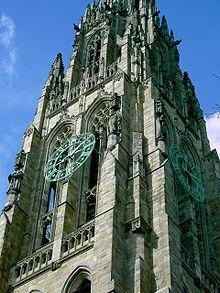
New Haven's growth continued during the two World Wars, with most new inhabitants being African Americans from the American South and Puerto Ricans. The city reached its peak population after World War II. The area of New Haven is only 17 square miles (44 km2), encouraging further development of new housing after 1950 in adjacent, suburban towns. Moreover, as in other U.S. cities in the 1950s, New Haven began to suffer from an exodus of middle-class workers.
In 1954, then-mayor Richard C. Lee began some of the earliest major urban renewal projects in the United States. Certain sections of downtown New Haven were destroyed and rebuilt with new office towers, a hotel, and large shopping complexes. Other parts of the city were affected by the construction of Interstate 95 along the Long Wharf section, Interstate 91, and the Oak Street Connector. The Oak Street Connector (Route 34), running between Interstate 95, downtown, and The Hill neighborhood, was originally intended as a highway to the city's western suburbs but was only completed as a highway to the downtown area, with the area to the west becoming a boulevard (See "Redevelopment" below).
In 1970, a series of criminal prosecutions against various members of the Black Panther Party took place in New Haven, inciting mass protests on the New Haven Green involving twelve thousand demonstrators and many well-known New Left political activists. (See "Political Culture" below for more information).
From the 1960s through the late 1990s, central areas of New Haven continued to decline both economically and in terms of population despite attempts to resurrect certain neighborhoods through renewal projects. In conjunction with its declining population, New Haven experienced a steep rise in its crime rate. In 2010, New Haven ranked as the 18th most dangerous city in America, albeit with crime rating under the significant safety benchmark of 200.00.
Since approximately 2000, many parts of downtown New Haven have been revitalized, with new restaurants, nightlife, and small retail stores. In particular, the area surrounding the New Haven Green has experienced an influx of apartments and condominiums. In recent years, downtown retail options have increased with the opening of new stores such as Urban Oufitters, J Crew, Origins, American Apparel, Gant Clothing, and an Apple Store, joining older stores such as Barnes & Nobles, Cutlers Records, and Raggs Clothing. In addition, downtown's growing residential population will be served by two new supermarkets, a Stop & Shop just outside of downtown and Elm City Market located one block from the Green. The recent turnaround of downtown New Haven has received positive press from various periodicals.
Major projects include the current construction of a new campus for Gateway Community College downtown, and also a 32-story, 500-unit apartment/retail building called 360 State Street. The 360 State Street project is now occupied and is the largest residential building in Connecticut. A new boathouse and dock is planned for New Haven Harbor, and the linear park Farmington Canal Trail is set to extend into downtown New Haven within the coming year. Additionally, foundation and ramp work to widen I-95 to create a new harbor crossing for New Haven, with an extradosed bridge to replace the 1950s-era Q Bridge, has begun. The city still hopes to redevelop the site of the New Haven Coliseum, which was demolished in 2007.
In April 2009 the United States Supreme Court agreed to hear a suit over reverse discrimination brought by 18 white firefighters against the city. The suit involved the 2003 promotion test for the New Haven Fire Department. After the tests were scored, no blacks scored high enough to qualify for consideration for promotion, so the city announced that no one would be promoted. In the subsequent Ricci v. DeStefano decision the court found 5-4 that New Haven's decision to ignore the test results violated Title VII of the Civil Rights Act of 1964. As a result, a district court subsequently ordered the city to promote 14 of the white firefighters.
In 2010 and 2011, state and federal funds were awarded to Connecticut (and Massachusetts) to construct the New Haven ae Hartford ae Springfield commuter rail line, with a southern terminus at New Haven's Union Station and a northern terminus at Springfield's Union Station. According to the White House, "This corridor [currently] has one train per day connecting communities in Connecticut and Massachusetts to the Northeast Corridor and Vermont. The vision for this corridor is to restore the alignment to its original route via the Knowledge Corridor in western Massachusetts, improving trip time and increasing the population base that can be served." Set for construction in 2013, the "Knowledge Corridor high speed intercity passenger rail" project will cost approximately $1 billion, and the ultimate northern terminus for the project is reported to be Montreal in Canada. Train speeds between will reportedly exceed 110 miles per hour (180 km/h) and increase both cities' rail traffic exponentially.
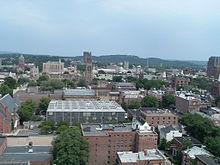
According to the United States Census Bureau, the city has a total area of 20.1 square miles (52.1 km2), of which 18.7 square miles (48.4 km2) is land and 1.4 square miles (3.7 km2), or 6.67%, is water.
New Haven's best-known geographic features are its large deep harbor, and two reddish basalt trap rock ridges which rise to the northeast and northwest of the city core. These trap rocks are known respectively as East Rock and West Rock, and both serve as extensive parks. West Rock has been tunneled through to make way for the east-west passage of the Wilbur Cross Parkway (the only highway tunnel through a natural obstacle in Connecticut), and once served as the hideout of the "Regicides" (see: Regicides Trail). Most New Haveners refer to these men as "The Three Judges". East Rock features the prominent Soldiers and Sailors war monument on its peak as well as the "Great/Giant Steps" which run up the rock's cliffside.
The city is drained by three rivers; the West, Mill, and Quinnipiac, named in order from west to east. The West River discharges into West Haven Harbor, while the Mill and Quinnipiac rivers discharge into New Haven Harbor. Both harbors are embayments of Long Island Sound. In addition, several smaller streams flow through the city's neighborhoods, including Wintergreen Brook, the Beaver Ponds Outlet, Wilmot Brook, Belden Brook, and Prospect Creek. Not all of these small streams have continuous flow year-round.
New Haven lies in the transition between a humid continental climate (Koppen climate classification: Dfa) and humid subtropical climate (Koppen Cfa), but having more characteristics of the former, as is typical of much of the New York metropolitan area. Summers are humid and very warm, with temperatures exceeding 90 °F (32 °C) on 7 ae8 days per year. Winters are cold with moderate snowfall interspersed with rainfall and occasionally mixed precipitation. The weather patterns that affect New Haven result from a primarily offshore direction, thus reducing the marine influence of Long Island Sound ae although, like other marine areas, differences in temperature between areas right along the coastline and areas a mile or two inland can be large at times.
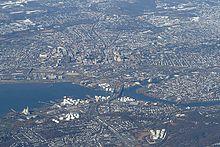
New Haven has a long tradition of urban planning and a purposeful design for the city's layout. The city could be argued to have some of the first preconceived layouts in the country. Upon founding, New Haven was laid out in a grid plan of nine square blocks; the central square was left open, in the tradition of many New England towns, as the city green (a commons area). The city also instituted the first public tree planting program in America. As in other cities, many of the elms that gave New Haven the nickname "Elm City" perished in the mid-20th century due to Dutch Elm disease, although many have since been replanted. The New Haven Green is currently home to three separate historic churches which speak to the original theocratic nature of the city. The Green remains the social center of the city today. It was named a National Historic Landmark in 1970.
Downtown New Haven, occupied by nearly 7,000 residents, has a more residential character than most downtowns. The downtown area provides about half of the city's jobs and half of its tax base and in recent years has become filled with dozens of new upscale restaurants, several of which have garnered national praise (such as Ibiza, recognized by Esquire and Wine Spectator magazines as well as the New York Times as the best Spanish food in the country), in addition to shops and thousands of apartments and condominium units which subsequently help overall growth of the city.
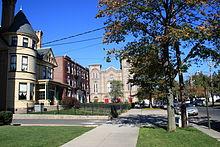
The city has many distinct neighborhoods. In addition to Downtown, centered on the central business district and the Green, are the following neighborhoods: the west central neighborhoods of Dixwell and Dwight; the southern neighborhoods of The Hill, historic water-front City Point (or Oyster Point), and the harborside district of Long Wharf; the western neighborhoods of Edgewood, West River, Westville, Amity, and West Rock-Westhills; East Rock, Cedar Hill, Prospect Hill, and Newhallville in the northern side of town; the east central neighborhoods of Mill River and Wooster Square, an Italian-American neighborhood; Fair Haven, an immigrant community located between the Mill and Quinnipiac rivers; Quinnipiac Meadows and Fair Haven Heights across the Quinnipiac River; and facing the eastern side of the harbor, The Annex and East Shore (or Morris Cove).
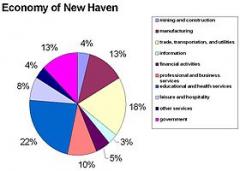
New Haven's economy originally was based in manufacturing, but the postwar period brought rapid industrial decline; the entire Northeast was affected, and medium-sized cities with large working-class populations, like New Haven, were hit particularly hard. Simultaneously, the growth and expansion of Yale University further affected the economic shift. Today, over half (56%) of the city's economy is now made up of services, in particular education and health care; Yale is the city's largest employer, followed by Yale ae New Haven Hospital. Other large employers include St. Raphael Hospital, Smilow Cancer Hospital, Southern Connecticut State University, Assa Abloy Manufacturing, the Knights of Columbus headquarters, Higher One, Alexion Pharmaceuticals, Covidien and United Illuminating. Yale and Yale-New Haven are also among the largest employers in the state, and provide more $100,000+-salaried positions than any other employer in Connecticut.
Industry sectors: Agriculture (.6%), Construction and Mining (4.9%), Manufacturing (2.9%), Transportation and Utilities (2.9%), Trade (21.7%), Finance and Real Estate (7.1%), Services (55.9%), Government (4.0%)
The US Census Bureau reports a 2010 population of 129,779; the 2010 census lists 47,094 households and 25,854 families within the city of New Haven. The population density is 6,859.8 people per square mile (2,648.6/km ²). There are 52,941 housing units at an average density of 2,808.5 per square mile (1,084.4/km ²). The racial makeup of the city is 43.46% White, 37.36% African American, 0.43% Native American, 1.90% Asian, 0.06% Pacific Islander, 10.89% from other races, and 3.91% from two or more races. Hispanic or Latino residents of any race were 9.39% of the population. Non-Hispanic Whites were 31.8% of the population in 2010, down from 69.6% in 1970. The city's demography is shifting rapidly: New Haven has always been a city of immigrants and currently the Latino population is growing rapidly. Previous influxes among ethnic groups have been African-Americans in the postwar era, and Irish, Italian and (to a lesser degree) Slavic peoples in the prewar period.
As of the 2010 US Census, of the 47,094 households, 29.3% have children under the age of 18 living with them, 27.5% include married couples living together, 22.9% have a female householder with no husband present, and 45.1% are non-families. 36.1% of all households are made up of individuals and 10.5% have someone living alone who is 65 years of age or older. The average household size is 2.40 and the average family size 3.19.
The ages of New Haven's residents are 25.4% under the age of 18, 16.4% from 18 to 24, 31.2% from 25 to 44, 16.7% from 45 to 64, and 10.2% who were 65 years of age or older. The median age is 29 years, which is statistically very young. There are 91.8 males per 100 females. For every 100 females age 18 and over, there are 87.6 males.
The median income for a household in the city is $29,604, and the median income for a family is $35,950. Median income for males is $33,605, compared with $28,424 for females. The per capita income for the city is $16,393. About 20.5% of families and 24.4% of the population live below the poverty line, including 32.2% of those under age 18 and 17.9% of those age 65 or over.
In 2006 the New York Times described New Haven as one of the poorest cities in the United States. As of 2001, the New Haven-Stamford-Bridgeport-Danbury metropolitan area had the third-highest per capita income in the country, behind San Francisco and Silicon Valley, California. But Stamford is one of the wealthiest cities in Connecticut, with a median per capita income of $34,987, over twice that in New Haven.
It is estimated that 14% of New Haven residents are pedestrian commuters, ranking it number four by highest percentage in the United States. This is primarily due to New Haven's small area and the presence of Yale University.
Today New Haven is a predominantly Roman Catholic city, as the city's Dominican, Irish, Italian, Mexican, Ecuadorian, and Puerto Rican populations are overwhelmingly Catholic. The city is part of the Archdiocese of Hartford. Jews also make up a considerable portion of the population, as do Black Baptists. There is a growing number of (mostly Puerto Rican) Pentecostals as well. There are churches for all major branches of Christianity within the city, multiple store-front churches, ministries (especially in working-class Latino and Black neighborhoods), a mosque, many synagogues (including two yeshivas), and other places of worship; the level of religious diversity in the city is high.
The Knights of Columbus, the world's largest Catholic fraternal service organization and a Fortune 1000 company, is headquartered in New Haven. Two more Fortune 1000 companies are based in Greater New Haven: the electrical equipment producers Hubbell, based in Orange, and Amphenol, based in Wallingford. Eight Courant 100 companies are based in Greater New Haven, with four headquartered in New Haven proper. New Haven-based companies traded on stock exchanges include NewAlliance Bank, the second largest bank in Connecticut and fourth-largest in New England (NYSE: NAL), Higher One Holdings (NYSE: ONE), a financial services firm United Illuminating, the electricity distributor for southern Connecticut (NYSE: UIL), Achillion Pharmaceuticals (NASDAQ: ACHN), Alexicon Pharmaceuticals (NasdaqGS: ALXN), and Transpro Inc. (AMEX: TPR). Vion Pharmaceuticals is traded OTC (OTC BB: VIONQ.OB). Other notable companies based in the city include the Peter Paul Candy Manufacturing Company (the candy-making division of the Hershey Company), the American division of Assa Abloy (one of the world's leading manufacturers of locks), Yale University Press, and the Russell Trust Association (the business arm of the Skull and Bones Society). The Southern New England Telephone Company (SNET) began operations in the city as the District Telephone Company of New Haven in 1878; the company remains headquartered in New Haven as a subsidiary of AT&T Inc., now doing business as AT&T Connecticut, and provides telephone service for all but two municipalities in Connecticut.
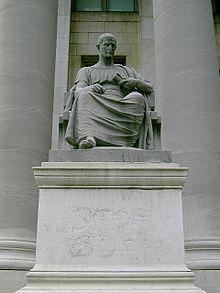
New Haven is governed via the mayor-council system. Connecticut municipalities (like those of neighboring states Massachusetts and Rhode Island) provide nearly all local services (such as fire and rescue, education, snow removal, etc.), as county government has been abolished since 1960. New Haven County merely refers to a grouping of towns and a judicial district, not a governmental entity. New Haven is a member of the South Central Connecticut Regional Council of Governments (SCRCOG), a regional agency created to facilitate coordination between area municipal governments and state and federal agencies, in the absence of county government.
John DeStefano, Jr., the current mayor of New Haven, has served eight consecutive terms and was re-elected for a record ninth term in November 2009. Mayor DeStefano has focused his tenure on improving education and public safety, as well as on economic development. Notable initiatives include the Livable City Initiative, begun in 1996, which promotes home ownership and removes blight, and the Citywide Youth Initiative. In 1995, DeStefano launched a 15-year, $1.5 billion School Construction Program, already half finished, to replace or renovate every New Haven public school. The mayor is elected by the entire city. The first mayor of New Haven was Roger Sherman.
The city council, called the Board of Aldermen, consists of thirty members, each elected from single-member wards. New Haven is served by the New Haven Police Department and the New Haven Fire Department.
New Haven lies within Connecticut's 3rd congressional district and has been represented by Rosa DeLauro since 1991. Martin Looney and Toni Harp represent New Haven in the Connecticut State Senate, and the city lies within six districts (numbers 92 through 97) of the Connecticut House of Representatives.
The Greater New Haven area is served by the New Haven Judicial District Court and the New Haven Superior Court, both headquartered at the New Haven County Courthouse. The United States District Court for the District of Connecticut has an office in New Haven, located in the Richard C. Lee U.S. Courthouse.
Crime increased in the 1990s, with New Haven having one of the ten highest violent crime rates per capita in the United States. In the late 1990s New Haven's crime began to stabilize. The city, adopting a policy of community policing, saw crime rates drop during the 2000s.
Violent crime levels vary dramatically between New Haven's neighborhoods, with some areas having crime rates in line with the state of Connecticut average, and others having extremely high rates of crime. A 2011 New Haven Health Department report identifies these issues in greater detail.
In 2010, New Haven ranked as the 18th most dangerous city in the United States (albeit below the safety benchmark of 200.00 for the second year in a row). However, according to a completely different analysis conducted by the "24/7 Wall Street Blog", in 2011 New Haven had risen to become the fourth most dangerous city in the United States, and was widely cited in the press as such.
However, an analysis by the Regional Data Cooperative for Greater New Haven, Inc., has shown that due to issues of comparative denominators and other factors, such municipality-based rankings can be considered inaccurate. For example, two cities of identical population can cover widely differing land areas, making such analyses irrelevant. The research organization called for comparisons based on neighborhoods, blocks, or standard methodologies (similar to those used by Brookings, DiversityData, and other established institutions), not based on municipalities.
See America's Safest and Most Dangerous Cities for more information.
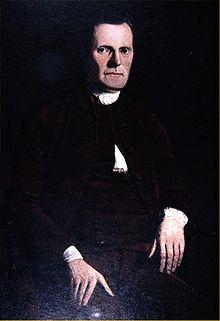
New Haven is the birthplace of former president George W. Bush, who was born when his father, former president George H. W. Bush, was living in New Haven while a student at Yale. In addition to being the site of the college educations of both Presidents Bush, New Haven was also the temporary home of former presidents William Howard Taft, Gerald Ford, and Bill Clinton. Clinton met his wife, current U.S. Secretary of State Hillary Rodham Clinton, while the two were students at Yale Law School. Former vice presidents John C. Calhoun and Dick Cheney also studied in New Haven (although the latter did not graduate from Yale). Before the 2008 election, the last time there was not a person with ties to New Haven and Yale on either major party's ticket was 1968. James Hillhouse, a New Haven native, served as President pro tempore of the United States Senate in 1801.
A predominantly Democratic city, New Haven voters overwhelmingly supported Al Gore in the 2000 election, Yale graduate John Kerry in 2004, and Barack Obama in 2008. In the 2008 election, New Haven County was third among all Connecticut counties in campaign contributions, after Fairfield and Hartford counties. (Connecticut, in turn, was ranked 14th among all states in total campaign contributions.)
New Haven was the subject of Who Governs? Democracy and Power in An American City, a very influential book in political science by preeminent Yale professor Robert A. Dahl, which includes an extensive history of the city and thorough description of its politics in the 1950s. New Haven's theocratic history is also mentioned several times by Alexis de Tocqueville in his classic volume on 19th-century American political life, Democracy in America. New Haven was the residence of conservative thinker William F. Buckley, Jr., in 1951, when he wrote his influential God and Man at Yale.
In 1970, the New Haven Black Panther trials took place, the largest and longest trials in Connecticut history. Black Panther Party co-founder Bobby Seale and ten other Party members were tried for murdering an alleged informant. Beginning on May Day, the city became a center of protest for 12,000 Panther supporters, college students, and New Left activists (including Jean Genet, Benjamin Spock, Abbie Hoffman, Jerry Rubin, and John Froines), who amassed on the New Haven Green, across the street from where the trials were being held. Violent confrontations between the demonstrators and the New Haven police occurred, and several bombs were set off in the area by radicals. The event became a rallying point for the New Left and critics of the Nixon Administration.
During the summer of 2007, New Haven was the center of protests by anti-immigration groups who opposed the city's program of offering municipal ID cards, known as the Elm City Resident Card, to illegal aliens. In 2008, the country of Ecuador opened a consulate in New Haven to serve the large Ecuadorean immigrant population in the area. It is the first foreign mission to open in New Haven since Italy opened a consulate (now closed) in the city in 1910.
In April 2009, the United States Supreme Court agreed to hear a suit over reverse discrimination brought by 20 white and Hispanic firefighters against the city. The suit involved the 2003 promotion test for the New Haven Fire Department. After the tests were scored, no blacks scored high enough to qualify for consideration for promotion, so the city announced that no one would be promoted. On 29 June 2009, the United States Supreme Court ruled in favor of the firefighters, agreeing that they were improperly denied promotion because of their race. The case, Ricci v. DeStefano, became highly publicized and brought national attention to New Haven politics due to the involvement of then-Supreme Court nominee (and Yale Law School graduate) Sonia Sotomayor in a lower court decision.
Garry Trudeau, creator of the political Doonesbury comic-strip, attended Yale University. There he met fellow student and later Green Party candidate for Congress Charles Pillsbury, a long-time New Haven resident for whom Trudeau's comic strip is named. During his college years, Pillsbury was known by the nickname "The Doones". A theory of international law, which argues for a sociological normative approach in regards to jurisprudence, is named the New Haven Approach, after the city. Current Connecticut Senator Joe Lieberman was a New Haven resident for years, before moving back to his hometown of Stamford.
New Haven is a notable center for higher education. Yale University, at the heart of downtown, is one of the city's best known features and its largest employer. New Haven is also home to Southern Connecticut State University, part of the Connecticut State University System, and Albertus Magnus College, a private institution. Gateway Community College has a campus in New Haven, located in the Long Wharf district; Gateway is in the process of consolidating into one campus and will move downtown into a new state-of-the-art campus (on the site of the old Macy's building) which is slated to open for the Fall 2012 semester.
There are several institutions immediately outside of New Haven, as well. Quinnipiac University and the Paier College of Art are located just to the north, in the town of Hamden. The University of New Haven is located not in New Haven but in neighboring West Haven.
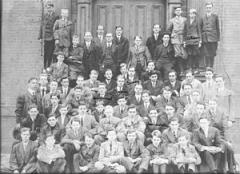
New Haven Public Schools is the school district serving the city. Wilbur Cross High School and Hillhouse High School are New Haven's two largest public secondary schools.
Hopkins School, a private school, was founded in 1660 and is the fifth-oldest educational institution in the United States. New Haven is home to a number of other private schools as well as public magnet schools, including Metropolitan Business Academy, High School in the Community, Hill Regional Career High School, Co-op High School, New Haven Academy, ACES Educational Center for the Arts, the Foote School and the Sound School, all of which draw students from New Haven and suburban towns. New Haven is also home to two Achievement First charter schools, Amistad Academy and Elm City College Prep, and to Common Ground, an environmental charter school.
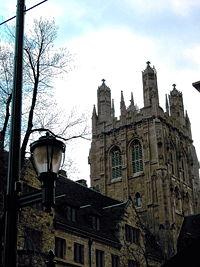
New Haven has many architectural landmarks dating from every important time period and architectural style in American history. The city has been home to a number of architects and architectural firms that have left their mark on the city including Ithiel Town and Henry Austin in the 19th century and Cesar Pelli, Warren Platner, Kevin Roche, Herbert Newman and Barry Svigals in the 20th. The Yale School of Architecture has fostered this important component of the city's economy. Cass Gilbert, of the Beaux-Arts school, designed New Haven's Union Station and the New Haven Free Public Library and was also commissioned for a City Beautiful plan in 1919. Frank Lloyd Wright, Marcel Breuer, Alexander Jackson Davis, Philip C. Johnson, Gordon Bunshaft, Louis Kahn, James Gamble Rogers, Frank Gehry, Charles Willard Moore, Stefan Behnisch, James Polshek, Paul Rudolph, Eero Saarinen and Robert Venturi all have designed buildings in New Haven. Yale's 1950s-era Ingalls Rink, designed by Eero Saarinen, was included on the America's Favorite Architecture list created in 2007.
Many of the city's neighborhoods are well-preserved as walkable "museums" of 19th- and 20th-century American architecture, particularly by the New Haven Green, Hillhouse Avenue and other residential sections close to Downtown New Haven. Overall, a large proportion of the city's land area is National (NRHP) historic districts. One of the best sources on local architecture is New Haven: Architecture and Urban Design, by Elizabeth Mills Brown.
The five tallest buildings in New Haven are:
There are 56 Zagat-rated restaurants in New Haven, the most in Connecticut and the third most in New England (after Boston and Cambridge). More than 120 restaurants are located within two blocks of the New Haven Green. The city is home to an eclectic mix of ethnic restaurants and small markets specializing in various foreign foods. Represented cuisines include Malaysian, Ethiopian, Spanish, French, Greek, Latin, Mexican, Italian, Thai, Chinese, Japanese, Vietnamese, Korean, Indian, Jamaican, Cuban, Peruvian, Syrian/Lebanese, and Turkish.
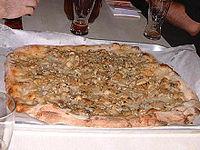
New Haven's greatest culinary claim to fame may be its pizza, which has been claimed to be among the best in the country, or even in the world. New Haven-style pizza, called "apizza" (pronounced ah-BEETS in the local dialect), made its debut at the iconic Frank Pepe Pizzeria Napoletana (known as Pepe's) in 1925. Apizza is baked in coal- or wood-fired brick ovens, and is notable for its thin crust. Apizza may be Red (with a tomato-based sauce) or White (with a sauce of garlic and olive oil), and pies ordered "plain" are made without the otherwise customary mozzarella cheese (pronounced sca-MOTZ, as it was originally smoked mozzarella, known as "scamorza" in Italian). A white clam pie is a well-known specialty of the restaurants on Wooster Street in the Little Italy section of New Haven, including Pepe's and Sally's Apizza (which opened in 1938). Modern Apizza, which opened in 1934 and is located on State Street, is also well-known.
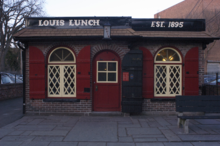
A second New Haven gastronomical claim to fame is Louis' Lunch, which is located in a small brick building on Crown Street and has been serving fast food since 1895. Though fiercely debated, the restaurant's founder Louis Lassen is credited by the Library of Congress with inventing the hamburger and steak sandwich. Louis' Lunch broils hamburgers, steak sandwiches and hot dogs vertically in original antique 1898 cast iron stoves using gridirons, patented by local resident Luigi Pieragostini in 1939, that hold the meat in place while it cooks.
New Haven is home to Miya's Sushi, one of America's first sustainable sushi restaurants. Miya's offers the largest vegetarian sushi menu in the world.[100][101][102]
During weekday lunchtime, over 150 lunch carts and food trucks from neighborhood restaurants cater to different student populations throughout Yale's campus.[103] The carts cluster at three main points: by Yale ae New Haven Hospital in the center of the Hospital Green (Cedar and York streets), by Yale's Trumbull College (Elm and York streets), and on the intersection of Prospect and Sachem streets by the Yale School of Management.[104] Popular farmers' markets set up shop weekly in several neighborhoods, including Westville/Edgewood Park, Fair Haven, Upper State Street, Wooster Square, and Downtown/New Haven Green.
A large hybrid co-op, the Elm City Market opened on 360 State Street in New Haven in early fall 2011. This is an independent and member owned grocery store that provides local produce and groceries to the community.[105]
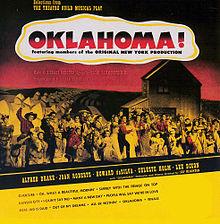
The city hosts numerous theatres and production houses, including the Yale Repertory Theatre, the Long Wharf Theatre, and the Shubert Theatre. There is also theatre activity from the Yale School of Drama, which works through the Yale University Theatre and the student-run Yale Cabaret. Southern Connecticut State University hosts the Lyman Center for the Performing Arts. The shuttered Palace Theatre (opposite the Shubert Theater) was rumored to being re-opened in 2008, but new development there is on hold. Smaller theaters include the Little Theater on Lincoln Street. Cooperative Arts and Humanities High School also boasts a state-of-the-art theater on College Street. The theater is used for student productions as well as the home to weekly services to a local non-denominational church, the City Church New Haven.[106]
The Shubert Theater once premiered many major theatrical productions before their Broadway debuts. Productions that premiered at the Shubert include Oklahoma! (which was also written in New Haven[107]), Carousel, South Pacific, My Fair Lady, The King and I, and The Sound of Music, as well as the Tennessee Williams play A Streetcar Named Desire.
Bow Tie Cinemas owns and operates the Criterion Cinemas, the first new movie theater to open in New Haven in over 30 years and the first luxury movie complex in the city's history. The Criterion has seven screens and opened in November 2004, showing a mix of upscale first run commercial and independent film.[108]
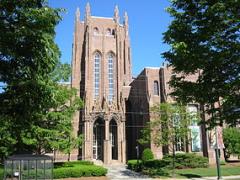
New Haven has a variety of museums, many of them associated with Yale. The Beinecke Rare Book and Manuscript Library features an original copy of the Gutenberg Bible. There is also the Connecticut Children's Museum; the Knights of Columbus museum near that organization's world headquarters; the Peabody Museum of Natural History; the Yale University Collection of Musical Instruments; the Eli Whitney Museum (across the town line in Hamden, Connecticut, on Whitney Avenue); the Yale Center for British Art, which houses the largest collection of British art outside the U.K.,[109] and the Yale University Art Gallery, the nation's oldest college art museum. New Haven is also home to the New Haven Museum and Historical Society on Whitney Avenue, which has a library of many primary source treasures dating from Colonial times to the present.
Artspace on Orange Street is one of several contemporary art galleries around the city, showcasing the work of local, national, and international artists. Others include City Gallery and A. Leaf Gallery in the downtown area. Westville galleries include Kehler Liddell, Jennifer Jane Gallery, and The Hungry Eye. The Erector Square complex in the Fair Haven neighborhood houses the Parachute Factory gallery along with numerous artist studios, and the complex serves as an active destination during City-Wide Open Studios held yearly in October.
New Haven is the home port of a life-size replica of the historical Freedom Schooner Amistad, which is open for tours at Long Wharf pier at certain times during the summer. Also at Long Wharf pier is the Quinnipiack schooner, offering sailing cruises of the harbor area throughout the summer. The Quinnipiack also functions as a floating classroom for hundreds of local students.
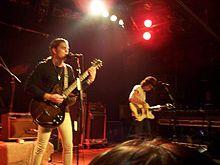
The New Haven Green is the site of many free music concerts, especially during the summer months. These have included the New Haven Symphony Orchestra, the July Free Concerts on the Green in July, and the New Haven Jazz Festival in August. The Jazz Festival, which began in 1982, was one of the longest-running free outdoor festivals in the U.S., until it was canceled for 2007. Headliners such as The Breakfast, Dave Brubeck, Ray Charles and Celia Cruz have historically drawn 30,000 to 50,000 fans, filling up the New Haven Green to capacity. The New Haven Jazz Festival has been revived for 2008 and 2009 under the sponsorship of Jazz Haven.[110]
New Haven is home to the concert venue Toad's Place. The city has retained an alternative art and music underground that has helped to influence post-punk era music movements such as indie, college rock and underground hip-hop. Other local venues include Cafe Nine, BAR, Stella Blues, Elm Bar, Firehouse 12, and Rudy's.
The Yale School of Music contributes to the city's music scene by offering hundreds of free concerts throughout the year at venues in and around the Yale campus. Hardcore band Hatebreed are from Wallingford, but got their start in New Haven under the name Jasta 14. The band Miracle Legion formed in New Haven in 1983.
In addition to the Jazz Festival (described above), New Haven serves as the home city of the annual International Festival of Arts and Ideas. New Haven's Saint Patrick's Day parade, which began in 1842, is New England's oldest St. Patty's Day parade and draws the largest crowds of any one-day spectator event in Connecticut.[111] The St. Andrew the Apostle Italian Festival has taken place in the historic Wooster Square neighborhood every year since 1900. Other parishes in the city celebrate the Feast of Saint Anthony of Padua and a carnival in honor of St. Bernadette Soubirous.[112] New Haven celebrates Powder House Day every April on the New Haven Green to commemorate the city's entrance into the Revolutionary War. The annual Wooster Square Cherry Blossom Festival commemorates the 1973 planting of 72 Yoshino Japanese Cherry Blossom trees by the New Haven Historic Commission in collaboration with the New Haven Parks Department and residents of the neighborhood. The Festival now draws well over 5,000 visitors. The Film Fest New Haven has been held annually since 1995.
In the past decade downtown has seen an influx of new restaurants, bars, and nightclubs. Large crowds are drawn to the Crown Street area downtown on weekends where many of the restaurants and bars are located. Crown Street between State and High streets has dozens of establishments, as do nearby Temple and College streets. Away from downtown, Upper State Street has a number of restaurants and bars popular with local residents and weekend visitors.
New Haven is served by the daily New Haven Register, the weekly "alternative" New Haven Advocate (which is run by Tribune, the corporation owning the Hartford Courant), the online daily New Haven Independent,[113] and the monthly Grand News Community Newspaper. Downtown New Haven is covered by an in-depth civic news forum, Design New Haven. The Register also backs PLAY magazine, a weekly entertainment publication. The city is also served by several student-run papers, including the Yale Daily News, the weekly Yale Herald and a humor tabloid, Rumpus Magazine. WTNH Channel 8, the ABC affiliate for Connecticut, WCTX Channel 59, the MyNetworkTV affiliate for the state, and Connecticut Public Television station WEDY channel 65, a PBS affiliate, broadcast from New Haven. All New York City news and sports team stations broadcast to New Haven County.
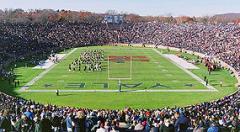
New Haven has a history of professional sports franchises dating back to the 19th century[114] and has been the home to professional baseball, basketball, football, hockey, and soccer teams aeincluding the New York Giants of the National Football League from 1973 to 1974, who played at the Yale Bowl. Throughout the second half of the 20th century, New Haven consistently had minor league hockey and baseball teams, which played at the New Haven Arena (build in 1926, demolished in 1972), New Haven Coliseum (1972 ae2002), and Yale Field (1928 aepresent).
When John DeStefano, Jr., became mayor of New Haven in 1995, he outlined a plan to transform the city into a major cultural and arts center in the Northeast, which involved investments in programs and projects other than sports franchises. As nearby Bridgeport built new sports facilities, the brutalist New Haven Coliseum rapidly deteriorated. Believing the upkeep on the venue to be a drain of tax dollars, the DeStefano administration closed the Coliseum in 2002; it was demolished in 2007. New Haven's last professional sports team, the New Haven County Cutters, left in 2009. The DeStefano administration did, however, see the construction of the New Haven Athletic Center in 1998, a 94,000-square-foot (8,700 m2) indoor athletic facility with a seating capacity of over 3,000. The NHAC, built adjacent to Hillhouse High School, is used for New Haven public schools athletics, as well as large-scale area and state sporting events; it is the largest high school indoor sports complex in the state.[115][116][117]
New Haven was the host of the 1995 Special Olympics World Summer Games; then-President Bill Clinton spoke at the opening ceremonies.[118] The city is home to the Pilot Pen International tennis event, which takes place every August at the Connecticut Tennis Center, one the largest tennis venues in the world.[119] New Haven biannually hosts "The Game" between Yale and Harvard, the country's second-oldest college football rivalry. Numerous road races take place in New Haven, including the USA 20K Championship during the New Haven Road Race.[120]
Greater New Haven is home to a number of college sports teams. The Yale Bulldogs play Division I college sports, as do the Quinnipiac Bobcats in neighboring Hamden. Division II athletics are played by Southern Connecticut State University and the University of New Haven (actually located in neighboring West Haven), while Albertus Magnus College athletes perform at the Division III level.
New Haven is a battleground city between fans of the Boston Red Sox and New York Yankees.[121] Walter Camp, deemed the "father of American football," was a New Havener.
The New Haven Warriors rugby league team play in the AMNRL. They have a large number of Pacific Islanders playing for them.[122] Their field is located at the West Haven High School's Ken Strong Stadium.[123] They won the 2008 AMNRL Grand Final.[124]
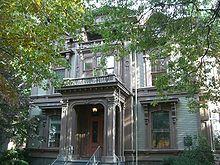
Many historical sites exist throughout the city, including 59 properties listed on the National Register of Historic Places. Of these, nine are among the 60 U.S. National Historic Landmarks in Connecticut. The New Haven Green, one of the National Historic Landmarks, was formed in 1638, and is home to three 19th-century churches. Below one of the churches (referred to as the Center Church on-the-Green) lies a 17th-century crypt, which is open to visitors. Some of the more famous burials include the first wife of Benedict Arnold and the aunt and grandmother of President Rutherford B. Hayes; Hayes visited the crypt while President in 1880.[125] The Old Campus of Yale University is located next to the Green, and includes Connecticut Hall, Yale's oldest building and a National Historic Landmark. The Hillhouse Avenue area, which is listed on the National Register of Historic Places and is also a part of Yale's campus, has been called a walkable museum, due to its 19th-century mansions and street scape; Charles Dickens is said to have called Hillhouse Avenue "the most beautiful street in America" when visiting the city in 1868.[126]
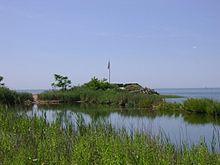
In 1660, Edward Whalley (a cousin and friend of Oliver Cromwell) and William Goffe, two English Civil War generals who signed the death warrant of King Charles I, hid in a rock formation in New Haven after having fled England upon the restoration of Charles II to the English throne.[127] They were later joined by a third regicide, John Dixwell. The rock formation, which is now a part of West Rock Park, is known as Judges' Cave, and the path leading to the cave is called the Regicides Trail.
After the American Revolutionary War broke out in 1776, the Connecticut colonial government ordered the construction of Black Rock Fort (to be built on top of an older 17th-century fort) to protect the port of New Haven. In 1779, during the Battle of New Haven, British soldiers captured Black Rock Fort and burned the barracks to the ground. The fort was reconstructed in 1807 by the federal government (on orders from the Thomas Jefferson administration), and rechristened Fort Nathan Hale, after the Revolutionary War hero who had lived in New Haven. The cannons of Fort Nathan Hale were successful in defying British war ships during the War of 1812. In 1863, during the Civil War, a second Fort Hale was built next to the original, complete with bomb-resistant bunkers and a moat, to defend the city should a Southern raid against New Haven be launched. The United States Congress deeded the site to the state in 1921, and all three versions of the fort have been restored. The site is now listed on the National Register of Historic Places and receives thousands of visitors each year.[128][129]
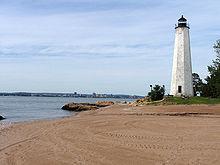
Grove Street Cemetery, a National Historic Landmark which lies adjacent to Yale's campus, contains the graves of Roger Sherman, Eli Whitney, Noah Webster, Charles Goodyear and Walter Camp, among other notable burials.[130] The cemetery is known for its grand Egyptian Revival gateway. The Union League Club of New Haven building, located on Chapel Street, is notable for not only being a historic Beaux-Arts building, but also is built on the site where Roger Sherman's home once stood; George Washington is known to have stayed at the Sherman residence while President in 1789 (one of three times Washington visited New Haven throughout his lifetime).[131][132]
Two sites pay homage to the time President and Chief Justice William Howard Taft lived in the city, as both a student and later Professor at Yale: a plaque on Prospect Street marks the site where Taft's home formerly stood, [133] and downtown's Taft Apartment Building (formerly the Taft Hotel) bears the name of the former President who resided in the building for eight years before becoming Chief Justice of the United States.[107]
Lighthouse Point Park, a public beach run by the city, was a popular tourist destination during the Roaring Twenties, attracting luminaries of the period such as Babe Ruth and Ty Cobb.[134] The park remains popular among New Haveners, and is home to the Five Mile Point Lighthouse, constructed in 1847, and the Lighthouse Point Carousel, constructed in 1916.[135][136] Five Mile Point Light was decommissioned in 1877 following the construction of Southwest Ledge Light at the entrance of the harbor, which remains in service to this day. Both of the lighthouses and the carousel are listed on the National Register of Historic Places.
Other historic sites in the city include the Soldiers and Sailors Monument, which stands at the summit of East Rock, the Marsh Botanical Garden, Wooster Square, Dwight Street, Louis' Lunch, and the Farmington Canal, all of which date back to the 19th century. Other historic parks besides the Green include Edgerton Park, Edgewood Park, and East Rock Park, each of which is included on the National Register of Historic Places.
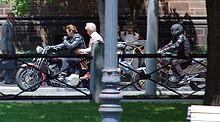
New Haven has been depicted in a number of movies. Scenes in the film All About Eve (1950) are set at the Taft Hotel (now Taft Apartments) on the corner of College and Chapel streets, and the history of New Haven theaters as Broadway "tryouts" is depicted in the Fred Astaire film The Band Wagon (1953). The city was fictionally portrayed in the Steven Spielberg movie Amistad (1997) concerning the events around the mutiny trial of that ship's rebelling captives. New Haven was also fictionalized in the movie The Skulls (2000), which focused on conspiracy theories surrounding the real-life Skull and Bones secret society which is located in New Haven.
Several recent movies have been filmed in New Haven, including Mona Lisa Smile (2003), with Julia Roberts, The Life Before Her Eyes (2007), with Uma Thurman, and Indiana Jones and the Kingdom of the Crystal Skull (2008) directed by Steven Spielberg and starring Harrison Ford, Cate Blanchett and Shia LaBeouf.[137] The filming of Crystal Skull involved an extensive chase sequence through the streets of New Haven. Several downtown streets were closed to traffic and received a "makeover" to look like streets of 1957, when the film is set. 500 locals were cast as extras for the film.[138][139] In Everybody's Fine (2009), Robert De Niro has a close encounter in what is supposed to be the Denver train station; the scene was filmed in New Haven's Union Station.
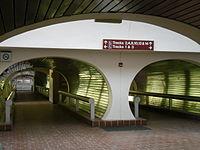
New Haven is repeatedly referenced by Nick Carraway in F. Scott Fitzgerald's literary classic The Great Gatsby, as well as by fellow fictional Yale alumnus C. Montgomery Burns, a character from The Simpsons television show. A fictional native of New Haven is Alex Welch from the novella, The Odd Saga of the American and a Curious Icelandic Flock.[140] The TV show Gilmore Girls is set (but not filmed) in New Haven and at Yale University, as are scenes in the film The Sisterhood of the Traveling Pants 2 (2008).
New Haven was the location of one of Jim Morrison's infamous arrests while he fronted the rock group The Doors. The near-riotous concert and arrest in 1967 at the New Haven Arena was commemorated by Morrison in the lyrics to "Peace Frog" which include the line "...blood in the streets in the town of New Haven..."[141] This was the first time a rock star had ever been arrested in concert. This event is portrayed in the movie The Doors (1991), starring Val Kilmer as Morrison, with a concert hall in Los Angeles used to depict the New Haven Arena.[142]
Pat Benatar released a DVD entitled Live in New Haven which shows a 1983 live concert performed at the New Haven Coliseum. Van Halen also has a DVD, Live Without a Net, which was filmed at the Coliseum in 1986.[143] New Haven and Louis' Lunch are depicted in the documentary Hamburger America (2004).[144]
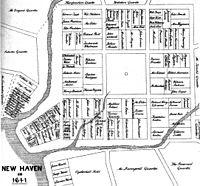
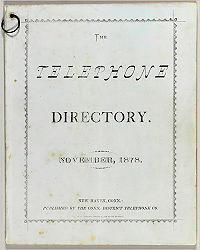
1638: New Haven (arguably) becomes the first planned city in America.
1776: Yale student David Bushnell invents the first American submarine.
1787: John Fitch builds the first steamboat.
1793: Eli Whitney invents the cotton gin.
1836: Samuel Colt invents the automatic revolver in Whitney's factory.
1839: Charles Goodyear of New Haven discovers the process of vulcanizing rubber in Woburn, Massachusetts, and later perfects it and patents the process in nearby Springfield, Massachusetts.[145]
1860: Philios P. Blake patents the first corkscrew.
1877: New Haven hosts the first Bell PSTN (telephone) switch office.
1878 ae1880: The District Telephone Company of New Haven creates the world's first telephone exchange and the first telephone directory and installs the first public phone. The company expanded and became the Connecticut Telephone Company, then the Southern New England Telephone Company (now part of AT&T).[146]
1882: The Knights of Columbus are founded in New Haven. The city still serves as the world headquarters of the organization, which maintains a museum downtown.[147]
1892: Local confectioner George C. Smith of the Bradley Smith Candy Co. invents the first lollipops.[148]
Late 19th century-early 20th century: The first public tree planting program takes place in New Haven, at the urging of native James Hillhouse.[149]
1900: Louis Lassen, owner of Louis' Lunch, is credited with inventing the hamburger, as well as the steak sandwich.[150]
1911: The Erector Set, the popular and culturally important construction toy, is invented in New Haven by A.C. Gilbert. It was manufactured by the A. C. Gilbert Company at Erector Square from 1913 until the company's bankruptcy in 1967.[151]
1920: In competition with competing explanations, the Frisbee is said to have originated on the Yale campus, based on the tin pans of the Frisbie Pie Company which were tossed around by students on the New Haven Green.[152]
1977: The first memorial to victims of the Holocaust on public land in America[153] stands in New Haven's Edgewood Park at the corner of Whalley and West Park avenues. It was built with funds collected from the community[154] and is maintained by Greater New Haven Holocaust Memory, Inc.[155] The ashes of victims killed and cremated at Auschwitz are buried under the memorial.[153]
The Greater New Haven Convention and Visitors Bureau has a more extensive list of New Haven firsts which can be found here.
The New Haven area supports several medical facilities that are considered some of the best hospitals in the country. There are two major medical centers downtown: Yale ae New Haven Hospital has four pavilions, including the Yale ae New Haven Children's Hospital and the Smilow Cancer Hospital; the Hospital of Saint Raphael is several blocks north, and touts its excellent cardiac emergency care program. Smaller downtown health facilities are the Temple Medical Center located downtown on Temple Street, Connecticut Mental Health Center, across Park Street from Y-NHH, and the Hill Health Center, which serves the working-class Hill neighborhood. A large Veterans Affairs hospital is located in neighboring West Haven. To the west in Milford is Milford Hospital, and to the north in Meriden is the MidState Medical Center.
Yale and New Haven are working to build a medical and biotechnology research mecca in the city and Greater New Haven region, and are succeeding to some extent. The city, state and Yale together run Science Park,[156] a large site three blocks northwest of Yale's Science Hill campus area.[157] This multi-block site, approximately bordered by Mansfield Street, Division Street, and Shelton Avenue, is the former home of Winchester's and Olin Corporation's 45 large-scale factory buildings. Currently, sections of the site are large-scale parking lots or abandoned structures, but there is also a large remodeled and functioning area of buildings (leased primarily by a private developer) with numerous Yale employees, financial service and biotech companies.
A second biotechnology district is being planned for the median strip on Frontage Road, on land cleared for the never-built Route 34 extension.[157] As of late 2009, a Pfizer drug-testing clinic, a medical laboratory building serving Yale ae New Haven Hospital, and a mixed-use structure containing parking, housing and office space, have been constructed on this corridor.[157] A former SNET telephone building at 300 George Street is being converted into lab space, and has been so far quite successful in attracting biotechnology and medical firms.[157]
New Haven is connected to New York City by commuter rail, regional rail and inter-city rail, provided by Metro-North Railroad (commuter rail), Shore Line East (commuter rail), and Amtrak (regional and intercity rail) respectively, allowing New Haven residents to commute to work in New York City (just under two hours by train).
The city's main railroad station is the historic Beaux-arts Union Station, which serves Metro-North trains to New York and Shore Line East commuter trains to New London. An additional station was opened in 2002, named State Street Station, to provide Shore Line East and a few peak-hour Metro-North passengers easier access to and from Downtown.
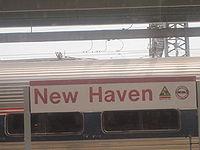
Union Station is further served by four Amtrak lines: the Northeast Regional and the high-speed Acela Express provide service to New York, Washington, D.C. and Boston, and rank as the first and second busiest routes in the country; the New Haven aeSpringfield Line provides service to Hartford and Springfield, Massachusetts; and the Vermonter provides service to both Washington, D.C., and Vermont, 15 miles (24 km) from the Canadian border.
Metro-North has the third highest daily ridership among commuter rails in the country, with an average weekday ridership of 276,000 in 2009. Of the 276,000 Metro-North riders, 112,000 rode the New Haven Line each day, which would make the New Haven Line seventh in the country in daily ridership if it were alone an entire commuter rail system. Shore Line East ranked nineteenth in the country, with an average daily ridership of 2,000.[158]
Plans for a high-speed, intercity commuter rail between New Haven's Union Station and Springfield, Massachusetts' Union Station are being developed, and as of 2011 hundreds of millions of dollars in both state and federal funding have been awarded to the project. Connecticut and Massachusetts officials "expect to complete all design work on the New Haven ae Hartford ae Springfield commuter rail line in 2013, and launch the new rail service in 2016." [159]
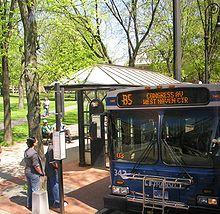
The New Haven Division of Connecticut Transit (CT Transit), the state's bus system, is the second largest division in the state with 24 routes. All routes originate from the New Haven Green, making it the central transfer hub of the city. Service is provided to 19 different municipalities throughout Greater New Haven. A map of the New Haven Division routes can be seen here, a map of downtown stops can be seen here, and a list of schedules can be seen here.
CT Transit's Union Station Shuttle provides free service from Union Station to the New Haven Green and several New Haven parking garages. Peter Pan and Greyhound bus lines have scheduled stops at Union Station, and connections downtown can be made via the Union Station Shuttle. A private company operates the New Haven/Hartford Express which provides commuter bus service to Hartford. The Yale University Shuttle provides free transportation around New Haven for Yale students, faculty, and staff.
The New Haven Division buses follow routes that had originally been covered by trolley service. Horse-drawn steetcars began operating in New Haven in the 1860s, and by the mid-1890s all the lines had become electric. In the 1920s and 1930s, some of the trolley lines began to be replaced by bus lines, with the last trolley route converted to bus in 1948. The City of New Haven is in the very early stages of considering the restoration of streetcar (light-rail) service, which has been absent since the postwar period.[160][161][162][163]
The Farmington Canal Trail is a rail trail that will eventually run continuously from downtown New Haven to Northampton, Massachusetts. The scenic trail follows the path of the historic New Haven and Northampton Company and the Farmington Canal. Currently, there is a continuous 14-mile (23 km) stretch of the trail from downtown, through Hamden and into Cheshire, making bicycle commuting between New Haven and those suburbs possible. The trail is part of the East Coast Greenway, a proposed 3,000-mile (4,800 km) bike path that would link every major city on the East Coast from Florida to Maine.
In 2004, a bike lane was added to Orange Street, connecting East Rock Park and the East Rock neighborhood to downtown.[164] The city has created recommended bike routes for getting around New Haven, including use of the Canal Trail and the Orange Street lane. A bike map of the city entire can be seen here, and bike maps broken down by area here.
The city has plans to create two additional bike lanes connecting Union Station with downtown, and the Westville neighborhood with downtown. The city is currently adding dozens of covered bike parking spots at Union Station, in order to facilitate more bike commuting to the station.[165]
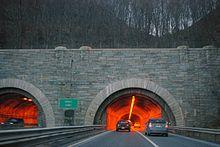
New Haven lies at the intersection of Interstate 95 on the coast ae which provides access southwards and/or westwards to the western coast of Connecticut and to New York City, and eastwards to the eastern Connecticut shoreline, Rhode Island, and eastern Massachusetts ae and Interstate 91, which leads northward to the interior of Massachusetts and Vermont and the Canadian border. I-95 is infamous for traffic jams increasing with proximity to New York City; on the east side of New Haven it passes over the Quinnipiac River via the Pearl Harbor Memorial, or "Q Bridge", which often presents a major bottleneck to traffic. I-91, however, is relatively less congested, except at the intersection with I-95 during peak travel times.
The Oak Street Connector (Connecticut Route 34) intersects I-91 at exit 1, just south of the I-95/I-91 interchange, and runs northwest for a few blocks as an expressway spur into downtown before emptying onto surface roads. The Wilbur Cross Parkway (Connecticut Route 15) runs parallel to I-95 west of New Haven, turning northwards as it nears the city and then running northwards parallel to I-91 through the outer rim of New Haven and Hamden, offering an alternative to the I-95/I-91 journey (restricted to non-commercial vehicles). Route 15 in New Haven is the site of the only highway tunnel in the state (officially designated as Heroes Tunnel), running through West Rock, home to West Rock Park and the Three Judges Cave.
The city also has several major surface arteries. U.S. Route 1 (Columbus Avenue, Union Avenue, Water Street, Forbes Avenue) runs in an east-west direction south of downtown serving Union Station and leading out of the city to Milford, West Haven, East Haven and Branford. The main road from downtown heading northwest is Whalley Avenue (partly signed as Route 10 and Route 63) leading to Westville and Woodbridge. Heading north towards Hamden, there are two major thoroughfares, Dixwell Avenue and Whitney Avenue. To the northeast are Middletown Avenue (Route 17), which leads to the Montowese section of North Haven, and Foxon Boulevard (Route 80), which leads to the Foxon section of East Haven and to the town of North Branford. To the west is Route 34, which leads to the city of Derby. Other major intracity arteries are Ella Grasso Boulevard (Route 10) west of downtown, and College Street, Temple Street, Church Street, Elm Street, and Grove Street in the downtown area.
Traffic safety is a major concern for drivers, pedestrians and cyclists in New Haven.[166] In addition to many traffic-related fatalities in the city each year, since 2005, over a dozen Yale students, staff and faculty have been killed or injured in traffic collisions on or near the campus.[167]
Tweed New Haven Regional Airport is located within the city limits 3 miles (5 km) east of the business district, and provides daily service to Philadelphia through US Airways. Bus service between Downtown New Haven and Tweed is available via the CT Transit New Haven Division Bus "G". Taxi service and rental cars (including service by Hertz, Avis, Enterprise and Budget) are available at the airport. Travel time from Tweed to downtown takes less than 15 minutes by car.

New Haven Harbor is home to the Port of New Haven, a deep-water seaport with three berths capable of hosting vessels and barges as well as the facilities required to handle break bulk cargo. The port has the capacity to load 200 trucks a day from the ground or via loading docks. Rail transportation access is available, with a private switch engine for yard movements and private siding for loading and unloading. Approximately 400,000 square feet (40,000 m2) of inside storage and 50 acres (200,000 m2) of outside storage are available at the site. Five shore cranes with a 250-ton capacity and 26 forklifts, each with a 26-ton capacity, are also available.
Electricity for New Haven is generated by a 448 MW oil and gas-fired generating station located on the shore at New Haven Harbor.[168] In addition, Pennsylvania Power and Light (PPL) Inc. operates a 220 MW peaking natural gas turbine plant in nearby Wallingford.
Near New Haven there is the static inverter plant of the HVDC Cross Sound Cable. There are three PureCell Model 400 fuel cells placed in the city of New Haven ae one at the New Haven Public Schools and newly constructed Roberto Clemente School,[169] one at the mixed-use 360 State Street building,[170] and one at City Hall.[171] According to Giovanni Zinn of the city's Office of Sustainability, each fuel cell may save the city up to $1 million in energy costs over a decade.[172] The fuel cells were provided by UTC Power.[173]
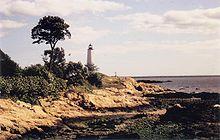
New Haven has six sister cities, as designated by Sister Cities International:
Some of these were selected because of historical connection ae Freetown because of the Amistad trial. Others, such as Amalfi and Afula-Gilboa, reflect ethnic groups in New Haven.
In 1990, the United Nations named New Haven a "Peace Messenger City".
Word Count: 12237





